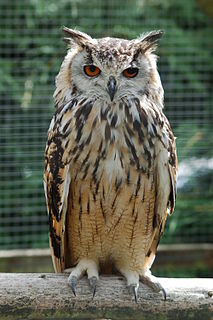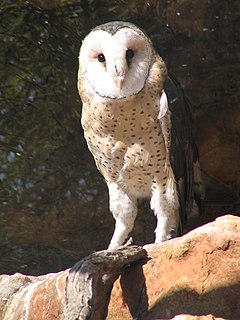
Owls are birds from the order Strigiformes, which includes over 200 species of mostly solitary and nocturnal birds of prey typified by an upright stance, a large, broad head, binocular vision, binaural hearing, sharp talons, and feathers adapted for silent flight. Exceptions include the diurnal northern hawk-owl and the gregarious burrowing owl.

The true owls or typical owls are one of the two generally accepted families of owls, the other being the barn owls (Tytonidae). The Sibley-Ahlquist taxonomy unites the Caprimulgiformes with the owl order; here, the typical owls are a subfamily Striginae. This is unsupported by more recent research, but the relationships of the owls in general are still unresolved. This large family comprises nearly 220 living species in 25 genera. The typical owls have a cosmopolitan distribution and are found on every continent except Antarctica. There are three accepted subfamilies of Strigidae including Striginae, Asioninae, and Surniinae.

The American horned owls and the Old World eagle-owls make up the genus Bubo, at least as traditionally described. The genus name Bubo is Latin for the Eurasian eagle-owl.

Tyto is a genus of birds consisting of true barn owls, grass owls and masked owls that collectively make up all the species within the subfamily Tytoninae of the barn owl family, Tytonidae.

Ninox is a genus of true owls comprising about 30 species found in Asia and Australasia. Many species are known as hawk-owls or boobooks, but the northern hawk-owl Surnia ulula is not a member of this genus. Molecular analysis indicates the genus is an early offshoot from the ancestors of the rest of the true owls, and are maybe best-classified in a subfamily Ninoxinae with the genera Sceloglaux and Uroglaux. The genus was introduced by the English naturalist Brian Houghton Hodgson in 1837.

The Cuban giant owl or giant cursorial owl (Ornimegalonyx) is an extinct genus of giant owl that measured 1.1 metres in height. It is closely related to the many species of living owls of the genus Strix. It was a flightless or nearly flightless bird and it is believed to be the largest owl that ever existed. It lived on the island of Cuba.
Buteogallus borrasi is a species of giant buteonine hawk which went extinct in the early Holocene. Formerly endemic to Cuba, this huge bird of prey probably fed on Pleistocene megafauna. Little is known about its appearance and ecology, so no common name has been given.
Paleontology or palaeontology is the study of prehistoric life forms on Earth through the examination of plant and animal fossils. This includes the study of body fossils, tracks (ichnites), burrows, cast-off parts, fossilised feces (coprolites), palynomorphs and chemical residues. Because humans have encountered fossils for millennia, paleontology has a long history both before and after becoming formalized as a science. This article records significant discoveries and events related to paleontology that occurred or were published in the year 1994.
Paleontology or palaeontology is the study of prehistoric life forms on Earth through the examination of plant and animal fossils. This includes the study of body fossils, tracks (ichnites), burrows, cast-off parts, fossilised feces (coprolites), palynomorphs and chemical residues. Because humans have encountered fossils for millennia, paleontology has a long history both before and after becoming formalized as a science. This article records significant discoveries and events related to paleontology that occurred or were published in the year 2002.
Paleontology or palaeontology is the study of prehistoric life forms on Earth through the examination of plant and animal fossils. This includes the study of body fossils, tracks (ichnites), burrows, cast-off parts, fossilised feces (coprolites), palynomorphs and chemical residues. Because humans have encountered fossils for millennia, paleontology has a long history both before and after becoming formalized as a science. This article records significant discoveries and events related to paleontology that occurred or were published in the year 1976.
Paleontology or palaeontology is the study of prehistoric life forms on Earth through the examination of plant and animal fossils. This includes the study of body fossils, tracks (ichnites), burrows, cast-off parts, fossilised feces (coprolites), palynomorphs and chemical residues. Because humans have encountered fossils for millennia, paleontology has a long history both before and after becoming formalized as a science. This article records significant discoveries and events related to paleontology that occurred or were published in the year 1972.

The Jamaican ibis, Jamaican flightless ibis or clubbed-wing ibis is an extinct bird species of the ibis subfamily uniquely characterized by its club-like wings. It is the only species in the genus Xenicibis, and one of only two flightless ibis genera, the other being the genus Apteribis endemic to Hawaii.

The LaBrea owl is an extinct owl reported from the upper Pleistocene asphalt deposits of the La Brea Tar Pits in Los Angeles, California. It was first described in 1933 by Hildegarde Howard as Strix brea, but this extinct owl was recently placed into its own genus by Campbell and Bocheński (2010). The Brea owl has also been found in the upper Pleistocene asphalt deposits of Carpinteria, California. Oraristrix brea is interpreted as more terrestrial in habits than forest owls because, compared to North American species of Bubo and Strix, it had longer legs relative to its wingspan.

The Madeiran scops owl is a small extinct owl that once inhabited the island of Madeira in the Macaronesian archipelago off the north-west coast of Africa in the North Atlantic Ocean.
The Cuban pauraque, also known as the Cuban poorwill, is an extinct species of nightjar from the island of Cuba in the Caribbean. It was described by Storrs Olson in 1985 from subfossil material he collected in 1980 from a hillside cave overlooking the village, and former historic port, of Daiquirí, about 20 km east of the city of Santiago de Cuba. The specific epithet refers to the type locality.
Gymnogyps varonai, sometimes called the Cuban condor, is an extinct species of large New World vulture in the family Cathartidae. G. varonai is related to the living California condor, G. californianus and the extinct G. kofordi, either one of which it may have evolved from. The species is solely known from fossils found in the late Pleistocene to early Holocene tar seep deposits in Cuba. G. varonai may have preyed upon carcasses from large mammals such as ground sloths.
The year 2013 in birding and ornithology.

Rivero's barn owl is an extinct species of barn owl that was very large — bigger than any extant barn owl species, and possibly larger than any known owl alive today. It is thought to have been nearly as large as another extinct gigantic owl, Ornimegalonyx. Suárez and Olson demoted T. riveroi as a junior synonym of Tyto pollens in 2015.
Oscar Paulino Arredondo de la Mata was a Cuban paleontologist. He described a number of birds and mammals of the Quaternary Period from fossils obtained from Cuban caves. He has been called the "father of Cuban vertebrate paleontology".









